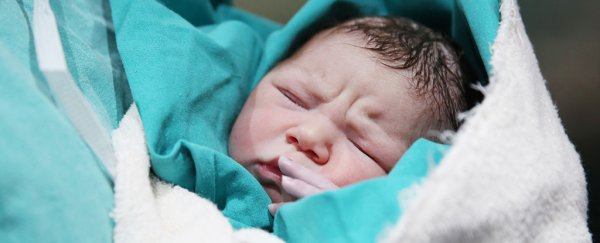Few fields of medical research attract controversy quite like those associated with childbirth and the risk of developmental disorders. Combined, it's a sensitive topic primed for a heated debate.
A recent review linking caesarean section deliveries with autism could be interpreted as a reason to push for a vaginal birth instead. But despite the impressive appearance of the meta-study's numbers, some experts argue it falls short of warranting advice for expectant mothers.
Scientists from Swedish and Spanish research institutes compiled data on a whopping 20 million caesarean and vaginal deliveries recorded in 61 observational studies, some of which were conducted as far back as the 1960s.
Their results suggest children delivered by C-section have a 1.33 times greater risk of falling on the autism spectrum, compared with children delivered vaginally. They also found similar numbers regarding the development of attention deficit disorder, finding 1.17 times increased risk for those delivered via C-section.
To most parents, any chance that their unborn child could face more hardship than necessary is reason to take notice. But amid emotional debates over whether caesarean deliveries lead to fatter babies or give babies the right kind of microbes, mothers already face intense judgement over their choice of birthing method.
Knowing there is a chance of an increased risk is all well and good. Understanding how it should affect our decisions is something else entirely.
University of Queensland obstetrics researcher Gino Pecoraro sees the significance of this kind of research in making sound decisions.
"Before undergoing any treatment, particularly elective treatment, it is important that doctors make patients aware of the options they have and their potential risks and benefits," says Pecoraro.
But he's also concerned about reading too much into the study's conclusions.
Calculating the chances any one child will be diagnosed with autism spectrum disorder is easier said than done. That figure could be as low as 0.6 percent in some parts of the world. The CDC estimates it could be as high as 1.69 percent.
If we use the CDC estimate, the absolute risk of autism increases just a little to 2.24 percent for C-section births, according to this latest research. Not only does this put a small jump in risk into perspective, it also reflects the difficulties in defining disorders like autism with consistency.
Pecoraro points out changes to the way researchers have diagnosed such disorders over time complicates research. While tens of millions of data samples seems impressive, it could be a problem if they don't agree on how autism should be defined.
It might not be enough to dismiss the study outright, but Pecoraro does urge caution in reading too deeply into its results.
"This study is certainly interesting and begs further prospective research be undertaken to try and answer the question of whether delivery by caesarean section increases the burden of mental health issues in children," he says.
"Ultimately, this study does not answer this question, but merely comes up with the correct recommendation that 'further research is required'."
It goes without saying that future investigations will build or shake confidence in the findings. But as controversial as the study might be, it's far from the first to identify a link.
The question over whether a correlation exists isn't what concerns so many researchers. It's that without clearer evidence of a mechanism, it's hard to judge any single preference for a caesarean delivery over a vaginal one given both come with serious risks and benefits.
Everything from anaesthesia to microflora has been suggested as a potential mechanism. Conditions that make a caesarean delivery preferable, such as developmental complications or low birth weight, might also affect a growing child's neurology.
"We know, for example, that caesarean sections are more common for pregnant women who are obese and older, and who have a history of immune conditions such as asthma," says Andrew Whitehouse, Bennett Chair of Autism at the University of Western Australia.
"All of these factors have also been linked with an increased chance of having a child with autism, and it is entirely possible – and some would argue, probable – that it is more likely these factors underlie the relationship between caesarean section and neurodevelopmental disorders."
With so many confounding factors – not to mention the cultural sensitivities around how we give birth and raise children – determining mechanisms behind the relationship will require some clever sleuthing.
Unlike experimental studies based on tweaking a single variable to study its effect, observational studies such as this draw inferences by searching for changes in a population.
Head of The Australian Collaborative Cerebral Palsy Research Group, Alastair MacLennan, argues the method carries too great a risk of bias slipping in.
"At best observational studies are 'hypothesis generators' and require prospective unbiased studies to confirm or deny the hypothesis generated in this study," says MacLennan.
"The many weaknesses in this study and the statistically small effect for just two of the many outcomes mean that no clinical conclusions can be drawn from these data."
Whether it's a caesarean or a vaginal delivery, drug free or carefully medicated, all birthing decisions come with risks and benefits that should be discussed with qualified medical professionals.
Weighing up those options is far from straightforward. While studies like this help fan the flames of debate, we really are going to need more research to make all choices as safe as possible.
This research was published in JAMA Network Open.
